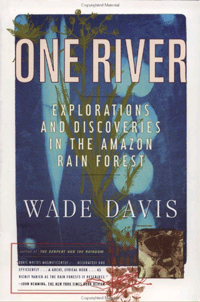Ethnobotanists, people who study the relationship between plants and people, have long been aware that rainforest dwellers have an astounding knowledge of medicinal plants.
For thousands of years, indigenous groups have extensively used rainforest plants for their health needs — the peoples of Southeast Asian forests used 6,500 species, while Northwest Amazonian forest dwellers used 1300 species for medicinal purposes. Today pharmacologists and ethnobotanists work with native healers and shamans in identifying prospects for development of new drugs. The yield from these efforts can be quite good — a study in Samoa found that 86% of the plants used by local healers yielded biological activity in humans — and the potential from such collaboration is huge with approximately one half of the anti-cancer drugs developed sine the 1960s are derived from plants.
Perhaps more staggering than their boundless knowledge of medicinal plants, is how shamans and medicinemen could have acquired such knowledge. There are over 100,000 plant species in tropical rainforests around the globe, how did indigenous peoples know what plants to use and combine especially when so many are either poisonous or have no effect when ingested. Many treatments combine a wide variety of completely unrelated innocuous plant ingredients to produce a dramatic effect. Some like curare of the Amazon are orally inactive, but when administered to muscle tissue are lethal.
 Kaiapo shaman in the Amazon. Kaiapo shaman in the Amazon.
|
No one knows how this knowledge was derived. Most say trial and error. Native forest dwellers say the knowledge was bestowed upon them by spirits of the rainforest. Whatever the mechanism, evidence from Amazonian natives suggests that indigenous knowledge of medicinal plants can develop over a relatively short period of time.
Ethnobotanists studying medicinal plant use by recently contacted tribes like the Waorani of Ecuador and the Yanomani of Brazil and Venezuela reported a relatively limited and highly selective use of medicinal plants. They had plants for treating fungal infections, insect and snake bites, dental ailments, parasites, pains and traumatic injuries. Their repertoire did not include plants to treat any Western diseases. In contrast, indigenous groups that have had a history of continuing contact with the outside world have hundreds of medicinal plants used for a wide range of conditions. It seems that after contact, in response to the introduction of Western diseases, these tribes accelerated their experimentation with medicinal plants. This notion contradicts the idea that indigenous knowledge of medicinal plants was accumulated slowly, over hundreds of years.
These questions are becoming increasingly academic as rainforests around the world continue to fall — the Amazon alone has lost more than 200,000 miles of forest since the 1970s — and indigenous populations vanish or become assimilated, often by choice, into mainstream society.

|
As youths from these communities leave their traditional societies, native cultures are forgotten and considerable knowledge about the processes for developing new medicinal recipes are lost forever.
Anthropologist Wade Davis has written two books that explore both the indigenous knowledge of plants and the disappearing cultures of the world. One River touches on the history of ethnobotany in the Amazon along with a plethora of other topics, while Light at the Edge of the World: A Journey Through the Realm of Vanishing Cultures presents photographs and stories from his 30 years of exploring the planet’s most remote regions. After reading these works, you will probably come away with the understanding that it’s important to know what we’re losing before it’s gone.
This article used information from mongabay.com, and One River by Wade Davis.